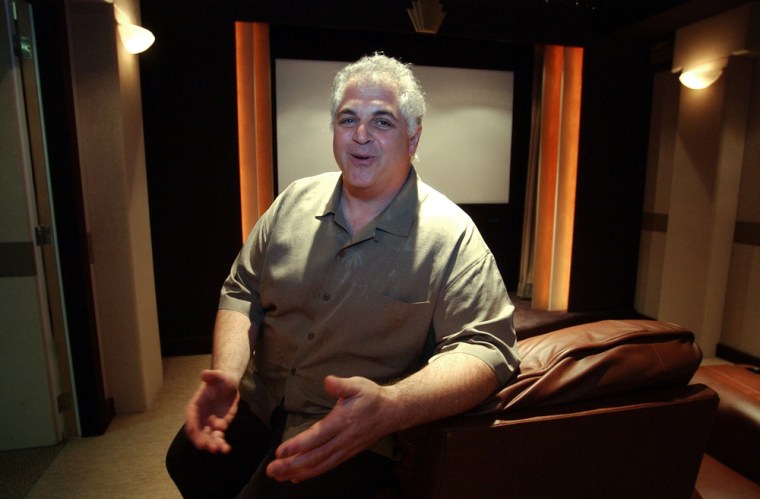Got an extra $125,000 lying around? Spending that much would get rid of boring, uncomfortable stays in shelters when the next monster hurricane hits.
The pricey safe room by Acoustic Innovations Inc. is among the many products companies are pitching to residents in hurricane-prone areas following last year's brutal season.
A room that can withstand hurricane-force winds isn't a unique concept. But the concrete room designed by Acoustic Innovations is built to offer more than protection. The steep price buys a home theater with a movie screen up to 14 feet wide, motorized leather recliners and other creature comforts.
"You probably would not be able to tell that a hurricane is going by while you're happily ensconced in the theater," said Jay Miller, the president and founder of the Boca Raton company, which has received at least two orders.
Acoustic Innovations, a home theater designer, decided to go into the hurricane protection business after last season's quartet of storms ravaged Florida and other Southeast states. But it's not the only company that has sized up the potential opportunities in hurricanes.
Other companies are pushing less expensive creations. They include alternatives to plywood or metal hurricane shutters to protect against flying debris. These fabric shields cost about the same as shutters, starting around $8 to $20 per square foot.
Armor Screen Corp. of Riviera Beach, Fla. uses trampoline-like woven plastic screening that is touted to take a hit from a two-by-four at about 60 mph without breaking. That's nearly twice the speed required under local building codes.
"Part of the reason for the strength is that there is a little bit of give," said president and founder Ted Gower.
The lightweight transparent screens also block most water and have withstood wind up to 276 mph in tests, he said. A 100-mph wind that hits screens comes through on the other side as a 3-mph breeze.
"We can actually put it out around a porch and the people can spend the hurricane around the porch," Gower said.
Another newer product can be used to replace old-fashioned sandbags, which can take many hours and people to put in place and don't always prevent flooding.
A puncture-resistant tube is filled with water, forming a flexible barrier that can be stacked on top of another, said Paul Vickers, president of U.S. Flood Control Corp. in Calgary, Alberta. Each tube is 50 feet long and 19 inches high, can be filled in 90 seconds and costs about $1,200.
Three tubes stacked in a 3-foot-high pyramid are enough to control 70 percent of floods, he said. A tarp wrapped around the tubes can hold back most flood water.
Two people can put together a pyramid, as opposed to the dozens of people needed to lay down sandbags, he said. And when the flooding passes, the water in the tubes can be drained and they can be stored. One tube weighs about 50 pounds empty and 6,000 pounds full.
One of the cheapest gadgets is the versatile Vector ToughBrite StormTracker, a portable television/radio/weather alert/spotlight/lantern. It costs $59.99 at Home Depot.
The weather alert radio automatically plays warnings on storms and other emergency information from the National Oceanic and Atmospheric Administration. It works on nine C batteries, regular AC power or a hand crank, which powers just the radio and a small light. The 5.5-inch black-and-white television can be tuned to signals broadcast over the airwaves.
But if a tiny TV screen isn't enough, a home theater safe room may be up your alley. Just have that second mortgage ready.
Miller got the idea after one of his clients told him how his family rode out a hurricane last year watching movies.
"I was thinking that, gee a client would want some place that they could watch a movie that is as soundproof as possible and as lightproof as possible," Miller said. "And thinking about that, it occurred to me that the amount of mass required to do that would also be perfect for preventing wind and rain from entering."
The room's floor, ceiling and walls need to be made of concrete and its door must be upgraded to have the same strength as an outdoor one. Then designers put in acoustic wall coverings to properly absorb the sound in the room and add cushy recliners, complete with drink holders.
Then come the electronics, which typically run about $60,000 alone, and another $5,000 or more to build a generator into the house to ensure a constant flow of power.
While that is a pricey way to stay safe in hurricanes, Miller said the rooms are not just for storms.
"After all, it's a family bonding experience. It's a great way to keep your kids at home," Miller said. "I have two daughters. I'd much rather have them in my home than out with their boyfriends."
